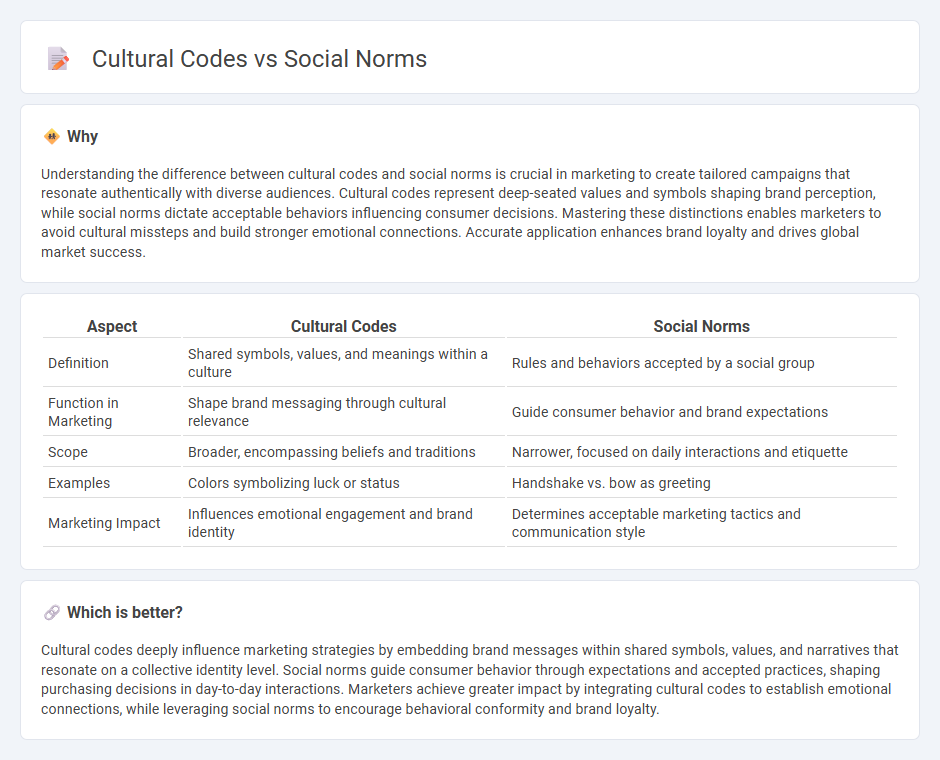
Cultural codes fundamentally shape consumer behavior by embedding values and symbols unique to each society, directly influencing marketing strategies. Social norms dictate the accepted behaviors within groups, guiding how brands tailor messages to resonate authentically with target audiences. Explore how understanding the contrasts between cultural codes and social norms can elevate your marketing effectiveness.
Why it is important
Understanding the difference between cultural codes and social norms is crucial in marketing to create tailored campaigns that resonate authentically with diverse audiences. Cultural codes represent deep-seated values and symbols shaping brand perception, while social norms dictate acceptable behaviors influencing consumer decisions. Mastering these distinctions enables marketers to avoid cultural missteps and build stronger emotional connections. Accurate application enhances brand loyalty and drives global market success.
Comparison Table
| Aspect | Cultural Codes | Social Norms |
|---|---|---|
| Definition | Shared symbols, values, and meanings within a culture | Rules and behaviors accepted by a social group |
| Function in Marketing | Shape brand messaging through cultural relevance | Guide consumer behavior and brand expectations |
| Scope | Broader, encompassing beliefs and traditions | Narrower, focused on daily interactions and etiquette |
| Examples | Colors symbolizing luck or status | Handshake vs. bow as greeting |
| Marketing Impact | Influences emotional engagement and brand identity | Determines acceptable marketing tactics and communication style |
Which is better?
Cultural codes deeply influence marketing strategies by embedding brand messages within shared symbols, values, and narratives that resonate on a collective identity level. Social norms guide consumer behavior through expectations and accepted practices, shaping purchasing decisions in day-to-day interactions. Marketers achieve greater impact by integrating cultural codes to establish emotional connections, while leveraging social norms to encourage behavioral conformity and brand loyalty.
Connection
Cultural codes shape marketing strategies by embedding symbols, values, and language that resonate with target audiences. Social norms influence consumer behavior and brand perception by defining acceptable and expected actions within a community. Understanding the interplay between cultural codes and social norms enables marketers to create culturally relevant campaigns that foster engagement and loyalty.
Key Terms
Behavioral Expectations
Social norms define the shared behavioral expectations within a community, guiding individuals on acceptable actions and interactions. Cultural codes encompass broader symbolic meanings and values embedded in traditions, rituals, and communication styles that influence behavior at a deeper level. Explore how understanding both concepts shapes effective social behavior and intercultural communication.
Value Systems
Social norms and cultural codes both reflect underlying value systems that guide behavior and expectations within a society. Social norms are informal rules rooted in shared values about acceptable conduct in daily interactions, while cultural codes are deeper symbolic systems that embody collective beliefs and moral principles shaping identity and meaning. Explore how these value-driven frameworks influence social cohesion and individual behavior in greater detail.
Group Identity
Social norms are unwritten rules that govern acceptable behavior within a group, shaping interactions and reinforcing group identity by promoting conformity. Cultural codes consist of shared symbols, language, and practices that communicate values and beliefs specific to a community, deeply embedding a sense of belonging and differentiation from others. Explore how understanding social norms and cultural codes can enhance your insight into group identity dynamics.
Source and External Links
Social norm - Social norms are shared standards of acceptable behavior governing members of a society, influencing behavior through informal understandings or codified rules, and vary by context and social group.
102 Examples of Social Norms (List) - Social norms are unspoken rules that guide social interactions, such as greeting people, saying "thank you," respecting personal space, and being polite in various everyday situations.
Social Norms - Veto Violence - CDC - Social norms are shared values, beliefs, and behaviors that influence individuals to conform, which can have both positive and negative effects on health and social outcomes.
 dowidth.com
dowidth.com